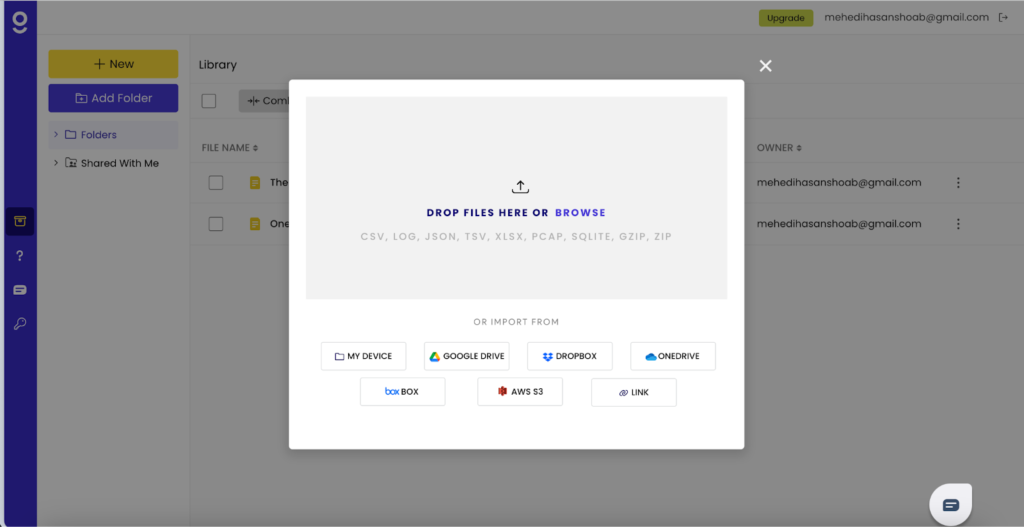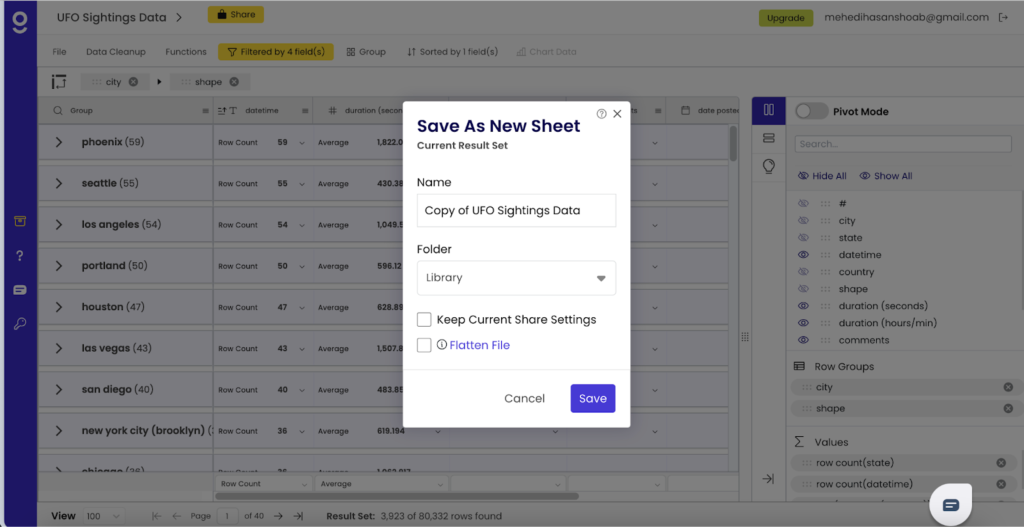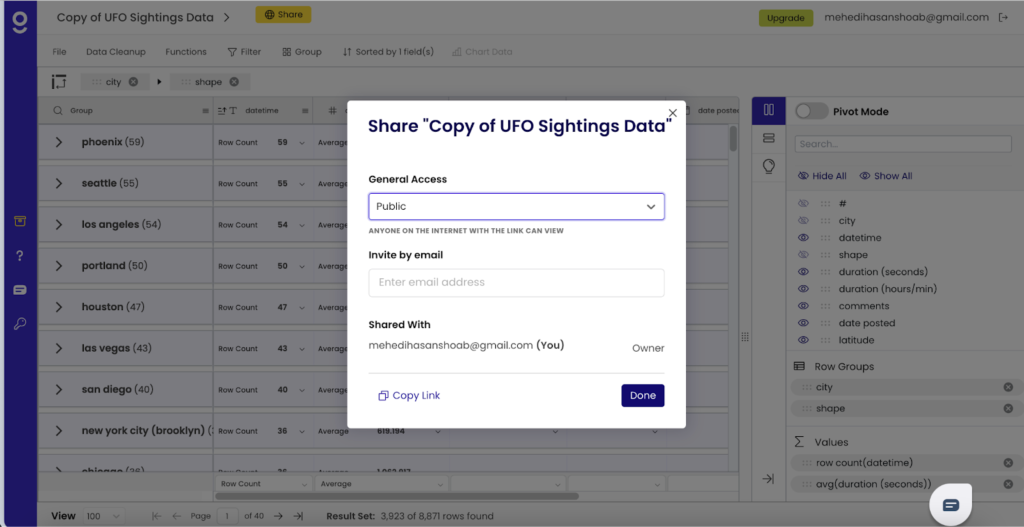How to Manage & Share Data Using Big Data Analysis Tools
Data is what propels businesses to drive massive revenues. It could improve customer experiences, marketing initiatives, and even money generation.
Companies profit from data collection, analysis, and insight. Every day, tons of data is stored on their consumer base. The tremendous increase in data and its importance has birthed entire streams of tools and careers centered on big data management.
Let’s be honest, we’re not talking about a few hundred data sets, the numbers can go up to millions and billions. The usual culprit, Excel is not a big data tool because it has a 1M row limit. Even Google Sheets can handle 10 million cells. So you can clearly imagine how huge the large CSV files can be.
Collaborating and accessing those files is so complicated that typical data management solutions can’t handle it.
In that case, why don’t you try Gigasheet, a free online data science spreadsheet tool that can help preview and transfer data without needing code or a database?
It can accommodate up to a billion rows of data without requiring software installation. Just upload your file and start collaborating with colleagues or securely share deliverables with clients.
Managing & Sharing Big Data Using Gigasheet (Step-by-Step)
There’s no end to who is using big data, starting from the healthcare, sporting industry to even multinational corporations focusing on cyber security are making extensive use of it.
Big data helps businesses understand their customers’ needs and desires and make better judgments in less time, making their jobs easier and more profitable.
Step 1: Get Your Data Transferred to Gigasheet
To start exporting a large amount of data, first, upload your data collection to Gigasheet.
When you initially open Gigasheet, your file list will be empty. To add your files, simply click the Add Data button. In the upper right corner of the files page, click the +NEW button and pick File Upload or Folder (you can see they support various formats).
When the uploads are finished, you will be directed to the Gigasheet Library. Here is a list of all the files you’ve imported or exported to Gigasheet. Your file type will be determined automatically by Gigasheet.

Alt Text: Upload Files to Gigasheet
Bring those massive data sets since Gigasheet is built to handle large files to help with big data management.
You can also upload your CSV file by clicking +New > File Upload > Browse to choose a file from your computer. To save time uploading, compress your file.
If you don’t want to download your file, at the lower half of the upload box, select the Link option and enter a publicly available URL to your CSV file or zip of a CSV.
Your CSV file will then be immediately uploaded (and unzipped if necessary). A loading bar will appear while the file parses for extremely huge files. After finishing, go to your Library and click on the file name to see the CSV file online. The viewer will display a spreadsheet in a new browser tab. You can filter here.
Step 2: Filter Your Data to Meet Your Needs
You’ve been tasked with narrowing it down to a more specific, targeted data set. Again, with the help of Gigasheet’s filtering features, this is simple.
When you filter your data set, only the rows that match are displayed and exportable. The filter menu can be selected by clicking on a column name and selecting “Filter” from the menu, or by clicking on the Filter symbol beneath the file name.
Suppose you want to figure out the number of UFO sightings in North America. This is what the master dataset looks like:
View without Logging In! https://app.gigasheet.com/spreadsheet/UFO-Sightings-Data/0cb3e2fa_a9d3_4687_b4bb_cbda4c236bad
With the filters, you can create complicated SQL-like queries without using any extra syntax. They can be stacked to cover a wide range of inclusions and exclusions.
To generate nested queries, use the AND and OR methods as shown below.
Alt-text: How to filter data using Gigasheet

Alt-text: Filtered data set on Gigasheet dashboard
Step 3: Share & Collaborate Using Your New Data Set
Gigasheet now lets you Save the filtered result into a new sheet. Just File -> Save As.
You can now present a custom huge data set to a customer or collaborate with an internal team. It allows multiple viewers to work on it simultaneously, and you can even publish the data by setting a file to the public.

Alt-text: How to save new data as a sheet
The Gigasheet Library saves all of our data and you can create multiple such sets depending on the information you need.
You’ll see a yellow Share button at the top of your file, you can click it to share your spreadsheet.
Alt-text: How to share data files using Gigasheet’s Restricted Access option
The general access is usually set to “Restricted” by default. This implies that no one else can access your spreadsheet except you.
You can then invite team members to work on the spreadsheet by entering their email addresses in the “Invite by Email” box.
Once you grant them access, change their permissions to “view” or “view and modify” based on your preferences. You can even revoke someone’s access by choosing “Share” and then selecting “remove” next to their email address.
On the other hand, if you want to share your spreadsheet with almost everyone, set “General Access” to “Public.” Copy the link and share it with just about anyone.
You can also share spreadsheets with grouping or applied filters so the person you shared it with can make greater sense of the data.

Alt-text: How to share data files using Gigasheet’s Public Access option
The user can filter, pivot, group, sort, and otherwise analyze the data from this view. However, to download or export the dataset, one must first create a Gigasheet account.
Once the data is available for your team, you can start building your data story by connecting the dots for them.
It might take hours and days with other big data analysis tools, especially if you have to learn how to configure it, master the tools, and design the dashboard.
For those who just want to browse the files, the Gigasheet interface includes a summary option that functions similarly to a simple dashboard. It organizes your data into an easy-to-use big data spreadsheet for instant visualization and analysis.
Sign Up for Gigasheet Now
Gigasheet is a web-based, billion-row spreadsheet. Thanks to it, anyone can quickly view and customize their data to meet their own needs.
Plus, with huge data sets, you don’t want to go through a series of crashes and reboots simply to process a spreadsheet. Now, switch to Gigasheet and give its free trial a shot!
Sign up here for free!
























